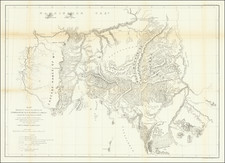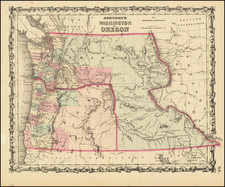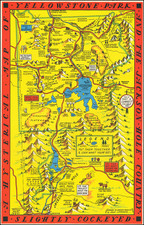Early Yellowstone Broadside Advertising Stereoviews of the Park.
Rare advertising broadside for William Marshall's stereoviews and lectures on Yellowstone.
The broadside was published following Marshall's years spent traveling to the Yellowstone shortly after it became a national park. The broadside advertises the lectures that Marshall was giving throughout the east coast, and it attests that he had already given some two hundred lectures on the subject. He also advertises his "calcium light" views.
At the top of the broadside is a small map of the park that has been called one of the earliest obtainable maps of Yellowstone (see the WorldCat entry). It shows Yellowstone and its northern and western surroundings. Interestingly, it depicts both the "Bozeman Road" and the "Wagon Road" to Virginia City. A projected branch of the Utah and Pacific Railroad into the park is shown. This rail line was never built, with service reaching the edge western of the park in 1907 but going no further.
Three engravings of the park are shown, depicting Giantess Geyser, Mammoth Hot Springs, and Yellowstone Falls. This broadside was published shortly before Marshall would embark on his fourth trip to the national park in 1881, this time taking tourists with him.
William Marshall: Early Yellowstone Tour Guide and Expert
William Isaac Marshall (1840-1906) was one of the earliest promoters of Yellowstone National Park. Marshall arrived in Montana Territory in July 1866 and resided in Virginia City through October 1875. He had arrived searching for gold, but he discovered the Yellowstone when he met the Hayden Survey party in 1871 while working on a mining claim.
Marshall stated that he visited Yellowstone with his family in 1873 and 1875, bragging that he took the first children ever (two of his own and one other of a co-traveler) through the park. In the mid-1870s, Marshall purchased a large Yellowstone and Montana photo collection from Joshua Crissman and sold the pictures under his own copyright. These views, which were titled simply "The National Park," reached at least number 122 in his series. He advertised and sold these views to teachers, clergymen, and others at his lectures on Yellowstone and by mail as promoted through articles he wrote about the park for National Education Association Proceedings. Marshall advertised commercial tours of Yellowstone, and he did bring at least one such group into the park, making him one of Yellowstone's earliest tour guides. A fellow traveler described him as:
A perfect gentleman in every way; highly educated, a fluent talker, and most obliging. He gave us all the information he had about the route we propose taking, and treated us as kindly as though we were members of his party. We afterwards heard that most of the tourists he conducted were pleased with the trip.
Despite this, Marshall found it difficult to take sufficient tourists into the park while charging a commercially viable price. It appears that he had undercharged during his first trip in 1881, and had shared plans to increase rates during his 1882 trip. His wife would later note that he only took tourists to the park in those two years.
In Marshall's later years, he returned to east as an educator and he was often referred to as "Professor" in various mentions of him. After 1875, he moved back to Fitchburg, Massachusetts, for his stereo views had the name of that place stamped on them with the copyright date of 1876, and his published articles gave that place as his residence. In 1887, he moved to Chicago where he became the principal of the Gladstone School. He apparently remained interested in Yellowstone for the rest of his life, because as late as 1902, he visited the park and was given a permit to collect geological specimens. He sent a book manuscript in 1904 to Park Superintendent John Pitcher for comments, and that book was subsequently published.
Dating
The OCLC entry for this map dates it to 1879. However, the map must date to 1881 given the dates on the verso, of April 14th falling on a Thursday and April 2nd falling on a Saturday. Each broadside likely has a slightly different date and imprint and verso, although it seems most likely that they were all printed within a year of each other and produced for the same lecture tour.
Rarity
We locate institutional examples at Yale, Montana State, Brigham Young, and the University of Utah.
We sold an example of in 2009, which is now in the collection of the University of Wyoming.











![(Nothern Half) [Bancroft's Map of the Pacific States]](https://storage.googleapis.com/raremaps/img/small/54924.jpg)




